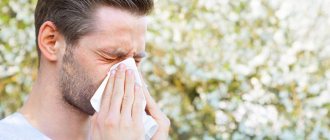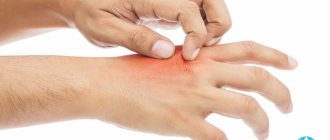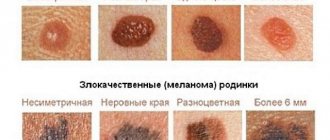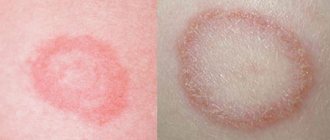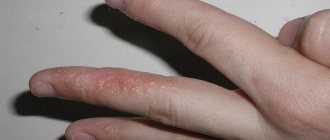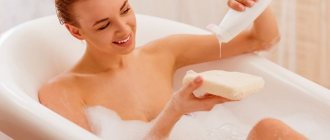Water blisters on the body are a sign of infection. The vesicles are filled with a clear or cloudy liquid, inside of which there are pathogens. The blisters may burst, leaving behind wounds that eventually crust over. Depending on the causes of the pathology, therapy is selected. The main thing is not to try to rip off, squeeze out or open the rash yourself. Otherwise, this can lead to additional inflammation and suppuration, resulting in scars remaining on the skin after recovery.
Causes of blisters
Pimples pop up on the skin, causing itching and redness, for many reasons. Here are the most popular:
- Insect bites. In this case, the appearance of redness and itching is caused by an allergic reaction of the body to the poison that entered the skin during the bite. The pain and intensity depends on the type of particular insect. A mosquito bite is not dangerous, but the stings of wasps and hornets in some cases can provoke the death of the victim due to anaphylactic shock.
- Allergy. With it, the body itches, small reddish pimples appear. The reaction may be accompanied by inflammation of the eyes, runny nose, difficulty breathing, and swelling.
- Plant juice. In Russia there are not many herbs that can cause harm when touched. The most famous stinging nettle is nettle; itchy pimples are painful and itchy, but safe in the absence of allergies, and then quickly disappear. Getting hogweed juice on your skin is much more dangerous. Under the sun's rays, a reaction begins, resulting in the appearance of huge bubbles filled with a yellowish liquid. They do not go away on their own, cause severe pain and can only be treated under the supervision of a doctor.
- Hives. One of the types of dermatitis, externally similar to a burn from the herb of the same name. Occurs as a reaction to an allergen or is a symptom of a disease.
- Mycosis. Blisters caused by a fungal infection that spreads not only to the skin, but also to the internal organs. In this case, the formations are pink and irregular in shape, sometimes peeling off.
- Neurodermatitis. Caused by an inflammatory process, which is a typical reaction to metabolic disorders in the body or diseases of internal organs. Exacerbation occurs in the cold season and when the immune system is weakened.
In some cases, acne appears due to endocrine disorders, infectious diseases, as well as certain tumors. If the skin rash does not go away within 1-2 days, you should definitely consult a doctor.
Causes of acne with fluid during pregnancy
Any type of rash on the body during pregnancy may indicate the presence of malfunctions in the functioning of internal organs and requires detailed diagnosis.
The most common reasons:
- Urticaria is most often formed as a result of the body’s reaction to food. Localized in the arms, abdomen, face. Accompanied by itching and looks like blisters with liquid contents;
- Miliaria - occurs most often in the last stages of pregnancy in the summer. Pimples with liquid contents form in the folds of the skin and under the abdomen; after damage to the membrane, a crust forms that itches and burns;
- Chicken pox - affects women if they have not previously had this type of disease;
- Dermatosis of pregnant women - forms in places where stretch marks form and manifests itself as blisters of a transparent color. Very often, this type of rash goes away on its own and does not require special treatment.
In addition to the main types of diseases that affect the period of bearing a child, a woman is not protected from the risk of contracting herpes or scabies, which also have symptoms such as the formation of blisters on the body.
What do vesicles look like?
In practice, doctors often encounter watery rashes that look like this:
- Small bubbles or vesicles.
- Large blisters or bullae.
- Bubbles with pus inside or pustules.
Typically, a vesicular rash or dermatitis is the main sign of a dermatological disease affecting the body. The clinical picture of the disease is clear. Bubbles collect in dense areas. Chickenpox in childhood is manifested by frequent accumulation of blisters with fluid inside.
The emergence process proceeds in the following order:
- The skin located at the site of the lesion becomes red. The patient feels discomfort in this place.
- Dots begin to form on the surface. As it increases, the inflammatory process intensifies.
- Itching appears and gradually becomes unbearable. Depending on what illness caused the blisters, additional symptoms and possibly pain may appear.
- As a result, the rash takes on the appearance of an open wound that grows on the surface and has a destructive effect deep in the skin.
If the appearance of blisters is not associated with an infectious infection, then the vesicles remain red pimples, located tightly to each other, causing itching.
How to recognize it in time?
A bubble or vesicle is a round formation on the surface of the skin, filled with clear or cloudy serous fluid with a diameter of up to 5 mm. The edging of the elements may be inflamed. After the contents are poured out, erosion appears - an open red wound. It becomes covered with a crust, which dries out and falls off, leaving no traces. Such symptoms are characteristic of allergic reactions, eczema, and herpes. Sometimes the blisters turn into pustules, which indicates the bacterial nature of the pathology (for example, with pemphigus). Inflammation affects the deeper layers of the skin, which is why scars remain after the tissue tightens. Combing the elements significantly slows down healing.
Hives
Urticaria (Uriticaria)
Sometimes also called nettle rash, urticaria is a dermatological condition characterized by pale red or white, raised, itchy rashes (blisters), each surrounded by a small red spot on the skin. The condition of the skin is very similar to a nettle burn.
According to Dermnetz.org, these blisters can be large, ranging in size from a few millimeters to several centimeters, making them look like swelling on the skin.
Hives are often associated with allergies, although there are many non-allergic causes. Allergic reactions promote the release of histamine and basophils, which then lead to damage to small blood vessels.
The rash may appear within minutes and go away within a few hours, and usually tends to change over time. The shape of the blisters varies from round and ring-shaped to uneven, reminiscent of a geographical map.
Although in most cases symptoms disappear in less than 24 hours, new blisters may appear as old ones clear up, sometimes migrating throughout the body.
Treatment
Hives are not a serious condition in most cases, and treatment is usually not required.
However, you can soothe the itching by taking an oral antihistamine, such as Zyrtec or Benadryl, or by applying calamine lotion. A cool bath may also help.
It is recommended to avoid exposure to any environmental elements or foods that may be a potential trigger for allergic reactions.
If this condition persists, you should consult your doctor. Steroid creams may need to be prescribed for a short period of time to reduce swelling. Antileukotriene therapy may also be prescribed to control histamine release.
First aid
If blisters form on the skin, which are symptoms of the disease, you must:
- Reduce the likelihood of damage to the integrity of formations;
- Remove contaminants from the affected area;
- If this is an allergic reaction, it is necessary to eliminate the possible allergen;
- Carefully treat the formation with alcohol;
- Do not use ointments and creams on your own;
- Contact a medical facility.
In case of burns, the following actions must be taken:
- Eliminate the factor that caused the skin damage;
- Clean the surface of the blister from contamination using boiled water at room temperature;
- Apply a cold compress to the blister;
- Treat with an antiseptic.
Calluses must be treated with an antiseptic drug and covered with a band-aid.
Blisters on the body itch due to illness
If rashes first appear and then disappear, and after a while they make themselves felt again, they are more likely symptoms of a hidden pathology. Diseases are distinguished by etiology and severity.
Eczema
The dermatological disease is inherited, is asymptomatic, but usually makes itself felt in the following cases:
- changes in hormonal levels;
- strong feelings;
- decreased immunity;
- inflammatory process.
In the acute form of eczema, the hands first itch, and when scratched, blisters appear in the form of a small rash. Mechanical damage provokes ulcers and expansion of the affected area.
Neurodermatitis
In a “dormant” state, pathology is in the body from birth. Neurodermatitis is also attributed to heredity. With poor nutrition, stress, vitamin deficiency, and digestive problems, the pathology makes itself felt with visible symptoms. First itching appears, then blisters.
When scratching the damaged area, there is a high probability of a fungal or viral infection.
Herpes
Severe itching, slight twitching, fever up to 39 degrees are symptoms of herpes activation. The next day the skin in this area will be covered with watery pimples. The aggravation lasts for at least a week. The rash gives way to a yellowish crust, the affected area is very itchy and burns.
Herpes is a viral infection that lives in the body for a long time without obvious signs. Hypothermia, a cold, decreased immunity, and a lack of nutrients in the body can “wake up” it. Immunity to infection is not developed.
Urticaria or urticaria
A rash on the body in the form of small or large red dots appears upon contact with certain foods, cold, heat and other factors that the body is not able to tolerate calmly.
Blisters appear on the body and are very itchy, but may disappear in a few hours or days without treatment. It is enough to exclude the allergen.
Scabies
Infection occurs through physical contact with a sick person or wearing his clothing. Microscopic scabies mites make tunnels under the skin. Due to mechanical damage and the accumulation of waste products of parasites, the body itches and blisters appear, which subsequently become inflamed. The itching worsens in the evening and at night.
Fungal infections
You can not only become infected with the disease, but also “acquire” it yourself. The fungus affects the feet when constantly wearing shoes without air circulation, and the palms when there is excessive sweating.
Symptoms of the pathology are watery small blisters between the fingers, an unpleasant putrid odor, and itching.
Chicken pox
This is an infectious disease to which immunity is subsequently developed. Small blisters cover the entire body and are very itchy. Most often, the disease is contracted in childhood, but adults can also become infected.
Shingles
At the initial stage, the patient feels malaise and nausea. Then, in the area of the trigeminal and intercostal nerves, bubbles filled with cloudy liquid appear. Bursting nodules are covered with a yellowish crust.
Parasite infestation
Roundworms and Giardia, which develop in the intestines, carry the risk of intoxication of the body. The patient's temperature rises, he is overcome by weakness, red blisters appear on his body, they itch, and the photo shows that they are grouped. First, when infected with parasites, the visual manifestation is noticeable on the palms and soles, then rashes may appear on other parts of the body.
Liver diseases
Impaired functioning of organs poses a serious threat to human health. With cirrhosis, hepatitis, or inflammation of the liver, an itching of unknown nature spreads throughout the body, and a rash on the chest and back is possible.
Diabetes
Increased glucose levels in the body are accompanied by itching. Often the problem area is the skin between the fingers. After vigorous scratching, watery pimples appear.
Malignant formations in the intestines
Small blisters on the body that itch slightly and do not cause much discomfort may indicate a dangerous tumor. This is one of the symptoms of a malignant neoplasm in the intestine.
When a pimple first appears, you shouldn’t panic, but you shouldn’t ignore the symptoms either. Timely consultation with a doctor will help prevent the complex course of the disease.
What to do if itching occurs?
If the blisters start to itch:
- Limit all possible contacts with the affected area (applies to infectious and viral diseases) healthy areas of the body can become infected;
- Apply a cold compress;
- Use an antihistamine (allergy and chicken pox);
- Treat with an antiseptic (for burns and calluses);
- Contact your doctor.
If necessary, a bandage can be applied to the area that is very itchy.
Atopic dermatitis: symptoms and treatment methods
The causes of atopic dermatitis are still unknown for sure. It can appear in both infants and adults. As a rule, at first the skin simply turns red. Over time, itching, burning, and small blisters begin to appear. “Favorite” places for atopic dermatitis: cheeks, lower back, shoulder blades, calves, forearms.
There is only one non-drug way to get rid of the manifestations of atopic dermatitis: a strict diet. As a rule, through selection, those products are determined, against the background of which dermatitis becomes less and eventually disappears completely.
There are also medicinal methods of treatment: for example, Advantan cream is highly active due to the content of corticosteroids in its composition. Already on the second or third day of treatment, the patient feels significant relief. The disadvantage of this remedy is that, as a rule, after stopping the drug, all the symptoms return again. The main key to the success of treatment is to eradicate the cause that caused the blisters to appear. Itchy legs, like insect bites, but there are no other symptoms - it is likely that the cause of this condition is atopic dermatitis.
Prevention
To reduce the risk of papules forming on the epidermis, the following prevention methods must be followed:
- Following a diet that reduces the consumption of allergenic foods;
- Do not use other people’s personal hygiene products and utensils;
- Avoid stressful situations;
- Increase the protective functions of the immune system with the help of vitamins;
- Treat all types of diseases in a timely manner;
- Avoid visiting public places during periods of exacerbation of viral infections;
- Maintain proper body hygiene;
- Reduce the risk of contact with infected people.
Following simple prevention rules will reduce the likelihood of infection and eliminate long-term treatment.
Causes of blisters
After the alarming symptoms have subsided for a while, the doctor will take samples to identify allergens.
Among the most common causes that lead to the appearance of foci of inflammation, but do not require long-term treatment and do not have serious health consequences, include:
Insect bites that result in blisters that are bothersome but go away quickly without medication. The formation of calluses as a result of rubbing the skin of the feet with uncomfortable shoes. Prolonged exposure to the sun, which resulted in overheating of the upper layers of the epidermis
It is important to use protective creams before going outside and be sure to lubricate your body with after-sun products. Burns from working with heating elements or failure to follow safety precautions during cooking. If the area exposed to high temperature is immediately treated with panthenol cream, the pain will go away and a blister will not form. Contact with skin unprotected by rubber gloves with chemicals.
A health problem can be much more serious when the causes of the rash are not so obvious. Some patients develop blisters on the body, they itch, go away on their own for a while and appear again.
In this case, we are talking about infection of the skin or problems with the functioning of internal organs. The main diseases that have similar symptoms are described below.
Scabies
The rashes can fester and become inflamed as a result of scratching. Itching occurs mainly in the evening. Treatment must be coordinated with a dermatologist without triggering the disease.
Fungal infections
You should not self-medicate, even if the cause of the illness is obvious. Only a dermatologist can prescribe a set of procedures to get rid of the infection.
Eczema
In this case, the skin of the hands, face and other areas become covered with blisters that itch very much.
As a result of mechanical damage, ulcers are formed that merge with each other.
Neurodermatitis
The blisters break out and merge into larger ulcers. Neurodermatitis is dangerous due to the appearance of a secondary infection when fungus or bacteria enter open wounds.
Herpes
Foci of inflammation are very itchy, aches and general weakness appear. The temperature rises to 39°C. Unlike chickenpox, immunity to this disease is not developed.
Urticaria or urticaria
In addition to these skin diseases, there are a number of problems in the functioning of internal organs that lead to the formation of blisters.
Infection with parasites (roundworms, lamblia)
For this reason, one of the first symptoms of the disease will be watery blisters affecting the hands and feet. Further, the rash can spread throughout the body. Additional signs of helminthiasis are weakness, fever, increased levels of bilirubin in the blood.
Malignant formations in the intestines
Only a doctor can make an accurate diagnosis after a thorough examination. You should not self-medicate, as in this case you can develop a more serious disease than ordinary urticaria.
Causes of blistering in newborns
In infants, formations with fluid may appear for the following reasons:
- Herpes – watery pimples appear in the mouth, nose and genitals. After a few days, the blister becomes purulent and can spread to healthy areas of the skin;
- Streptoderma is the formation of large purulent blisters on the skin, most often appearing in the face area, after which it spreads throughout the body;
- Enterovirus is a viral infection of the body in which blisters with liquid appear, which tend to form in almost any part of the body;
- Pemphigus is the appearance of a watery rash with a rim around the formation. Most often occurs in the oral cavity on the abdomen and arms;
- Allergic rash - most often occurs on food, appears on the face in the form of papules with purulent content;
- Miliaria is a fairly common phenomenon in newborn children, especially in the summer, in the heat, since their skin is very sensitive to temperature changes and any other irritants.
Very often, blisters appear on the skin of newborns as a result of poor-quality clothing that causes irritation.
Treatment and preventive measures
Bubbles filled with liquid cause great inconvenience for a person, as they are accompanied by a clear burning sensation, and then itching, and therefore require immediate treatment.
When blisters appear on the skin and itch, the first priority is to find out the nature of the occurrence, after which only the direction of treatment can be determined.
If a blister pops up and itches due to an infectious disease, then treatment will take place exclusively in a hospital setting, accompanied by therapy in the form of antibiotics. Patients with diabetes mellitus must be monitored by a doctor, since even a small blister (often formed on the legs) can lead to dire consequences - a trophic ulcer, and then even gangrene. For an accurate diagnosis, it is necessary to observe all precautions, namely, not to disturb the surface of the blisters (do not scratch, do not burst, do not wear too tight clothes).
Without using any dressings, it is possible and even necessary to use zinc ointment to lubricate the damaged surface.
It is also necessary to use a disinfecting lotion, which includes silver (easy to find in any pharmacy).
To narrow blood vessels, you can use witch hazel ointment; its action is similar to calamine lotion.
When treating such cases, milk of magnesia and the drug Pepto-Bismol are also prescribed.
Please note that when self-medicating with these drugs, you must strictly adhere to the instructions. Hydrocortisone ointment is also widely used in such cases.
It is used with extreme caution; if the ointment does not give any positive results, and the situation only worsens, then immediately consult a dermatologist
Hydrocortisone ointment is also widely used in such cases.
It is used with extreme caution; if the ointment does not give any positive results, and the situation only worsens, then immediately consult a dermatologist
Therapy with folk remedies
To relieve inflammation and soothe unbearable itching on the body, the following remedy is prepared for blisters - soda porridge. To do this, you need to take regular soda and add enough water to it to get a thick, homogeneous mass. This remedy is applied to the affected areas (itchy blisters) to eliminate the burning sensation.
A similar remedy is prepared from ordinary vinegar. Take a teaspoon of vinegar and mix with warm water, then use a cotton pad to wipe the sore spots.
If blisters have formed on the body and itch as a result of an allergic reaction, you can get rid of them with the help of nettle tincture. This remedy is used internally as tea.
If you notice the slightest irritating appearance on the body, which is accompanied by itching, burning, under no circumstances scratch them or try to disrupt the integrity of their surface.
Urgently make an appointment with a dermatologist who will prescribe the necessary treatment and vitamin complex.
Now you will know what to do if your skin itches and blisters.
Dermatological pathologies, as a rule, do not pose a threat to health, but they cause serious discomfort to their owner and often even cause a decrease in performance. What should you do if blisters appear on your body, they itch like insect bites, and cause pain and discomfort? Of course, you should visit a dermatologist and get qualified advice. However, you can often independently determine the reason why the blisters, similar to bites, itch and hurt. The article presents a list of the main pathologies that cause such symptoms and treatment methods.
Classification and manifestation of fluid blisters
Blisters on the skin that contain fluid inside are classified according to the following classification:
- Symptomatic;
- Allergic blisters;
- Mechanical effect on the skin.
Symptomatic blisters
This type of formation is one of the main symptoms of an infectious disease.
Formations appear as follows:
- Small blisters form;
- The formation contains a clear liquid;
- The thin film on the formation is quickly damaged and turns into a wound;
- It can form in almost any part of the body.
Allergy blisters
They are a symptom of skin surface contact with an allergen. Very often, allergic rashes appear after using low-quality cosmetics or contact with plants.
Formations appear as follows:
- Redness appears on the skin, which turns into a large number of small blisters with liquid;
- The formations create a large number of unpleasant sensations for a person, including a feeling of itching;
- They tend to disappear quickly after using antihistamines;
- Most often they appear on the arms, shoulders and legs.
As a result of mechanical action on the skin
The appearance of such blisters is promoted by contact with hot objects and direct sunlight, as well as damage to the epidermis.
Such formations have the following properties:
- Large blisters;
- Occurs directly at points of contact;
- Can persist for a long time;
- Upon palpation, a person feels pain;
- After the bubble is damaged, a wound is formed in its place;
- Most often they occur on the arms, legs, and shoulders.
When this kind of blisters appears on the body, it is forbidden to comb them and damage their integrity, otherwise infection may occur and the disease may worsen.
Therapy
The course of medications is prescribed only by a doctor. Self-medication when a rash occurs is unacceptable; it often becomes a threat to the patient and the people around him. Treatment for itchy blisters is aimed at eliminating the underlying cause, after which the rash begins to disappear.
It is forbidden to scratch the rash or intentionally open its elements; this sometimes leads to infection of the wounds. The bubbles should burst spontaneously.
Traditional medicine
If the rash is caused by viruses (herpes, chickenpox), antiviral drugs are used:
Antihistamines are prescribed to relieve itching:
Blisters are treated with antiseptics:
- brilliant green;
- Fukortsin;
- potassium permanganate solution.
Herpes on the lips can be treated with ointments:
To relieve fever, pain and inflammation use:
To treat contact dermatitis, use:
- antiallergenic agents (Claritin, Loratadine, Diazolin);
- corticosteroids (Sinaflan, Advantan, Dermovate, Lokoid);
- enterosorbents (Polysorb, activated carbon);
- immunomodulators (tincture of echinacea, ginseng, eleutherococcus);
- multivitamins (Alphabet, Vitrum).
- corticosteroids (Hydrocortisone, Lorinden);
- antihistamines (Bepanten, Elokom, Advantan).
Fungal infections are treated with:
- local medications (Mikospor, Lotseril, Lamisil, Exoderil);
- antifungal drugs taken orally (Terbizil, Griseofulvin, Flucostat);
- sorbents (Enterosgel, Polysorb MP);
- immunomodulators (tincture of echinacea, ginseng, eleutherococcus).
Streptoderma is suppressed using:
- antiseptics for treating rashes (salicylic alcohol, brilliant green, Fukortsin);
- ointments with antibiotics (Triderm, Erythromycin ointment, Baneocin).
If a bacterial infection is added to the underlying cause of the rash with watery blisters, use:
- antibiotics (Augmentin, Amoxicillin, Erythromycin);
- immunomodulators (Immunal, Immunorm, echinacea extract, ginseng, eleutherococcus).
Folk remedies
Traditional medicine is added to complex treatment. Allergic reactions are relieved with herbal decoctions:
- Yarrow. Brew 1 tablespoon of the plant in 250 ml of boiled water. Let it brew for 1 hour. Drink 1 glass 3 times a day. The course of treatment is 21 days. The product successfully fights cold allergies.
- A series. In the evening, boil 1 liter of water, pour 4 tablespoons of the plant into the liquid, and leave until the morning. Take half a glass 3 times a day. Treatment lasts 21 days. The sequence is useful for food allergies.
Fungal infections are treated using the following:
- Strong coffee. The grains are ground in a coffee grinder, brew 5 teaspoons in 500 ml of boiling water, allow to cool to 37-40 0 C. Take 15-minute baths, immersing your hands or feet in the healing solution.
- Tea tree oil. The affected areas are treated with oil 3 times a day. The product is applied with a cotton pad. The skin stops peeling and itching, the blisters dry out and heal.
Baths and lotions with oak bark help cure dyshidrosis and prickly heat:
- For 2 liters of boiling water, take 8 tablespoons of plant material. The solution is cooled to 37-40 0 C, and baths are taken. The duration of the procedure is 15-20 minutes.
- Brew 1 teaspoon of bark in 250 ml of boiling water. When the infusion has cooled to a comfortable temperature, moisten a napkin in it and apply it to the affected area. Leave the application until it dries.
With the correct diagnosis and timely treatment, itchy blisters heal quickly without causing complications.
Every person who is faced with the problem of a skin disease, like no one else, can tell you what unpleasant sensations itching and burning of the skin causes.
When this kind of discomfort occurs, you want to find out the causes of any formations on the skin as soon as possible in order to quickly eliminate them.
Most often, the body becomes blistered and itchy.
Such formation interferes with a person’s normal life activities, since the blister itches. What is the reason for their appearance and methods of treatment - we will talk about this in our article.
Therapy
The course of medications is prescribed only by a doctor. Self-medication when a rash occurs is unacceptable; it often becomes a threat to the patient and the people around him. Treatment for itchy blisters is aimed at eliminating the underlying cause, after which the rash begins to disappear.
It is forbidden to scratch the rash or intentionally open its elements; this sometimes leads to infection of the wounds. The bubbles should burst spontaneously.
Traditional medicine
If the rash is caused by viruses (herpes, chickenpox), antiviral drugs are used:
- Virolex;
- Acyclovir.
Antihistamines are prescribed to relieve itching:
- Claritin;
- Tavegil;
- Zyrtec;
- Suprastin.
Blisters are treated with antiseptics:
- brilliant green;
- Fukortsin;
- potassium permanganate solution.
Herpes on the lips can be treated with ointments:
- Penciclovir;
- Acyclovir.
To relieve fever, pain and inflammation use:
- Ibuprofen;
- Lidocaine gel;
- Paracetamol;
- Aspirin.
To treat contact dermatitis, use:
- antiallergenic agents (Claritin, Loratadine, Diazolin);
- corticosteroids (Sinaflan, Advantan, Dermovate, Lokoid);
- enterosorbents (Polysorb, activated carbon);
- immunomodulators (tincture of echinacea, ginseng, eleutherococcus);
- multivitamins (Alphabet, Vitrum).
Dyshidrosis is treated:
- corticosteroids (Hydrocortisone, Lorinden);
- antihistamines (Bepanten, Elokom, Advantan).
Fungal infections are treated with:
- local medications (Mikospor, Lotseril, Lamisil, Exoderil);
- antifungal drugs taken orally (Terbizil, Griseofulvin, Flucostat);
- sorbents (Enterosgel, Polysorb MP);
- immunomodulators (tincture of echinacea, ginseng, eleutherococcus).
Streptoderma is suppressed using:
- antiseptics for treating rashes (salicylic alcohol, brilliant green, Fukortsin);
- ointments with antibiotics (Triderm, Erythromycin ointment, Baneocin).
If a bacterial infection is added to the underlying cause of the rash with watery blisters, use:
- antibiotics (Augmentin, Amoxicillin, Erythromycin);
- immunomodulators (Immunal, Immunorm, echinacea extract, ginseng, eleutherococcus).
Folk remedies
Traditional medicine is added to complex treatment. Allergic reactions are relieved with herbal decoctions:
- Yarrow. Brew 1 tablespoon of the plant in 250 ml of boiled water. Let it brew for 1 hour. Drink 1 glass 3 times a day. The course of treatment is 21 days. The product successfully fights cold allergies.
- A series. In the evening, boil 1 liter of water, pour 4 tablespoons of the plant into the liquid, and leave until the morning. Take half a glass 3 times a day. Treatment lasts 21 days. The sequence is useful for food allergies.
Fungal infections are treated using the following:
- Strong coffee. The grains are ground in a coffee grinder, brew 5 teaspoons in 500 ml of boiling water, allow to cool to 37-40 C. Take 15-minute baths, immersing your hands or feet in the healing solution.
- Tea tree oil. The affected areas are treated with oil 3 times a day. The product is applied with a cotton pad. The skin stops peeling and itching, the blisters dry out and heal.
Baths and lotions with oak bark help cure dyshidrosis and prickly heat:
- For 2 liters of boiling water, take 8 tablespoons of plant material. The solution is cooled to 37-40 C, and baths are taken. The duration of the procedure is 15-20 minutes.
- Brew 1 teaspoon of bark in 250 ml of boiling water. When the infusion has cooled to a comfortable temperature, moisten a napkin in it and apply it to the affected area. Leave the application until it dries.
With the correct diagnosis and timely treatment, itchy blisters heal quickly without causing complications.
Treatment with folk remedies
The use of folk remedies can reduce unpleasant symptoms and eliminate the appearance of skin rashes:
- Peach oil – reduces the likelihood of damage to formations, eliminates itching. Apply a small amount of oil to the affected area and leave until completely absorbed. Not for use in case of individual sensitivity to the component;
- Baths with medicinal herbs help provide an antibacterial effect and eliminate itching. It is necessary to mix chamomile flowers, calendula, nettle leaves, and oak bark in equal proportions. Pour water over all ingredients and bring to a boil. Leave to infuse for 30 minutes, strain and add to a bath of water. Use this bath every day for 20 minutes. It is forbidden to dry yourself with a towel; you must carefully blot the liquid;
- Aloe juice has antibacterial and antiviral properties. Grind the aloe leaf and soak it in water for several hours. Strain the mixture, moisten a piece of gauze, apply to the damage for 20 minutes;
- Series - used to relieve inflammation. Bring a small amount of herb to a boil, cool and strain. Moisten a cotton swab and apply to the rash on the epidermis. Used during pregnancy and from the first days of life.
Before using traditional medicine measures, it is necessary to conduct a sensitivity test.
Why does the body itch?
The reasons for itching the body in different places may be different. Among them are general and skin diseases, allergies, and insect bites. To establish the cause of persistent itching, you need to consult a doctor who will offer to donate blood and urine for general clinical tests. If an allergy is suspected, appropriate tests are used, which allows you to quickly identify the allergen and remove it from the environment or menu.
Rash on the body due to allergies
If a person is prone to allergic reactions, then upon contact with an allergen, the brain sends a signal about a large release of histamine, a hormone that causes the sensation of itching. Prolonged scratching of the skin can lead to infection and the onset of an inflammatory process. Usually the body itches in different places in turn and does not go away for a long time precisely due to an allergy to something. If such symptoms appear, you should consult a doctor who will determine the allergen. It often happens that a person has not complained about negative reactions all his life, but suddenly an allergy to the most common product appears.
In cases where the body itches in different places and spots appear, the skin becomes covered with rashes, whether it is an allergy or not can be established in a simple way.
You need to lightly press the area with the rash with your finger, and then quickly remove it, as in the photo. If the rash is of allergic origin, then the spot will remain pale for a while after you remove your finger. If the itching and rash are related to skin diseases or infections, then after removing the finger the rash will not change color, but will remain red.
Infectious diseases
Having carried out your own diagnosis using this method, still do not delay going to the doctor. Any skin rash may be a sign of infectious diseases:
Rash on the body due to rubella
- measles;
- scarlet fever;
- measles rubella;
- chickenpox and others.
In children, these infections are usually mild, but adults suffer from childhood illnesses with difficulty. The sooner the disease is identified and treated, the less consequences there will be.
In addition to skin diseases, the body itches in different places and red spots appear after insect bites. These include:
Spot after a tick bite
- mites;
- bees and wasps;
- mosquitoes;
- ground fleas and others.
- The body reacts to the poison that gets under the skin with a rush of blood, which, together with insect toxins, leads to burning and itching.
Skin diseases
If at first the body itches in different places, then changes in the skin appear in the form of spots, as in the photo, this is typical for psoriasis.
Psoriasis spots
Other diseases that affect the skin:
- lichen planus;
- seborrhea;
- dermatitis of various origins;
- mycosis (fungus);
- xeroderma (mild form of ichthyosis).
All of these diseases can be treated with medications with varying degrees of success.
In what cases is it necessary to consult a doctor?
If blisters form on the skin, you should seek help from a medical facility in the following situations:
- The blisters appeared for an unknown reason as a symptom of some disease;
- The formations arose in the child;
- The contents of pimples have purulent contents;
- The rash quickly spreads throughout the body;
- The rash is accompanied by unpleasant symptoms;
- The burn is large;
- The rash is accompanied by inflammation and swelling of the skin.
All types of skin rashes require consultation with a specialist; you should not self-medicate.
